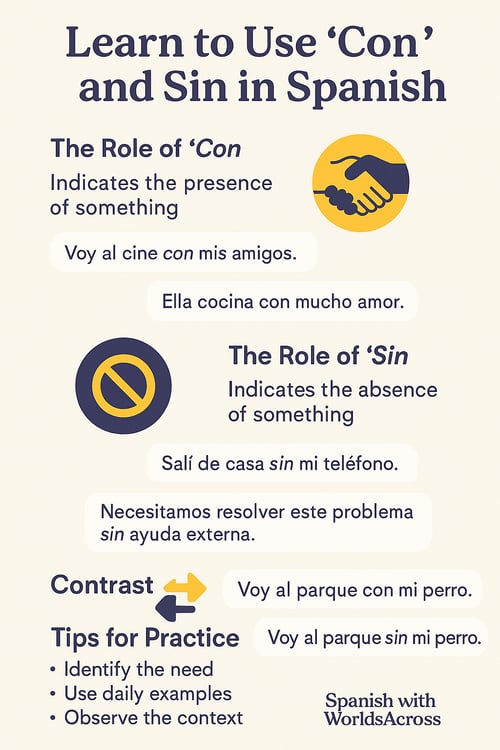
Have you ever wondered how small words can completely change the meaning of a sentence? Prepositions in Spanish are those small details that make all the difference. Among them, "con" and "sin" play a crucial role in daily communication. Though they may seem simple, understanding the use of "con" and "sin" can transform your ability to express yourself in Spanish. In this article, we will explore the fascinating world of Spanish prepositions, focusing on the differences between "con" and "sin."
The Role of "Con"
The preposition "con" is used to indicate the presence of something or someone in an action or situation. This preposition suggests companionship or a relationship between elements. Its usage is quite versatile and can be applied in various contexts. This is a clear example of the use of "con" and "sin."
Examples:
- Voy al cine con mis amigos.
- Ella cocina con mucho amor.
In both examples, "con" indicates a relationship or company, whether of people or qualities.
The Role of "Sin"
On the other hand, "sin" is used to indicate the absence of something or someone. This preposition denotes the lack of a condition, object, or companionship, and can have a significant impact on the meaning of the sentence.
Examples:
- Salí de casa sin mi teléfono.
- Necesitamos resolver este problema sin ayuda externa.
Here, "sin" shows the lack or absence of something necessary or expected.
Differences Between "Con" and "Sin"
Understanding the differences between "con" and "sin" is essential for using prepositions in Spanish correctly. In summary:
The main difference lies in the fact that "con" implies the presence of something, while "sin" denotes its absence.
- "Con": Used to add elements or companionship to an action or situation.
- "Sin": Used to indicate that something or someone is absent from the action or situation.
Comparative Example:
- Voy al parque con mi perro.
- Voy al parque sin mi perro.
In the first case, "con" adds the presence of the dog, while in the second case, "sin" indicates its absence. This contrast clearly illustrates the differences between "con" and "sin."
Tips for Using "Con" and "Sin" in Practice
To master the use of "con" and "sin," consider these practical tips:
- Identify the Need: Ask yourself if you need to add something or show its absence.
- Use Daily Examples: Practice with sentences that reflect everyday situations to reinforce your understanding.
- Observe the Context: The context of the conversation will help you decide which preposition to use.
Remember that mastering the use of "con" and "sin" requires practice and attention, but with patience, you will become an expert.

By understanding the use of "con" and "sin," you’ll be ready to express your ideas clearly and communicate without misunderstandings. These prepositions not only add nuances to your sentences but also allow you to connect ideas with precision and maintain coherence effortlessly.
At WorldsAcross, we offer the perfect guidance for you to immerse yourself in the Spanish language. Join us and take the first step with confidence, mastering Spanish without complications and enjoying every moment of the process!



